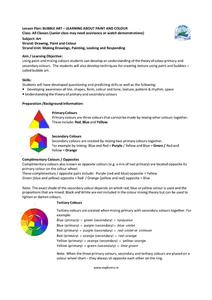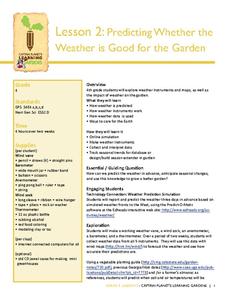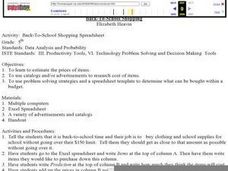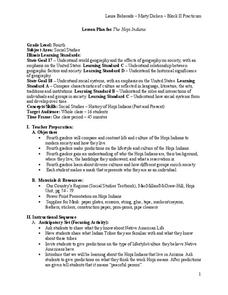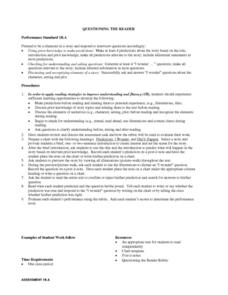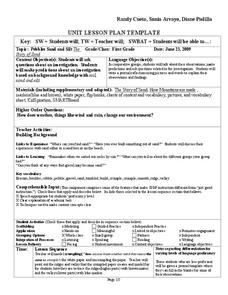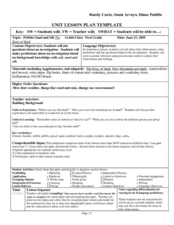Marine Institute
Bubble Art – Learning About Paint and Color
To gain an understanding of color mixing theory and the color wheel, young artists draw a picture, mix up a batch of secondary colors to which they add dish soap, and using straws, bubble up the paint. They then press their drawings onto...
Mathed Up!
Stratified Sampling
Young mathematicians learn how to solve problems involving stratified sampling. They review concepts of sampling and proportionality by watching a video and then they complete a worksheet of questions on this topic.
Captain Planet Foundation
Predicting Whether the Weather is Good for the Garden
Can your class predict the weather? Show them how they can come close with a lesson about creating weather instruments, including weather vanes, barometers, wind socks, anemometers, and thermometers. Kids research weather patterns and...
Curated OER
Back-To-School Shopping
Fifth graders estimate the prices of items to be bought for back to school. They use catalogs and/or advertisements to research the cost of each of the items. They use problem solving strategies and a spreadsheet template to determine...
Curated OER
Thomas Edison's Inventions in the 1900s and Today: From "New" to You!
Students research types of technology available to Americans at the beginning of the 20th century and compare the style of living to modern times. They identify Thomas Edison's contributions to technology and their own current lifestyles.
Curated OER
Discovering Pi/Welcome to Pi Day
Students explore pi. In this circle measurement lesson, students define and identify radius, diameter, circumference, and perimeter. Students work in groups to measure several plastic lids and record their findings. Students compare the...
Baylor College
Drugs, Risks and the Nervous System
In cooperative groups, middle schoolers contemplate the probability of 18 different situations occurring. After they make predictions, they compare them to the actual risk factors. This eye-opening exercise demonstrates that the odds of...
Curated OER
Koala Lou
First graders predict what will happen in different parts of the story Koala Louby Mem Fox. In this predictions lesson plan, 1st graders say and write their predictions.
Curated OER
Jellybean Graphs
Second graders predict and graph data based on the color of jelly beans they think are in a handful. In this prediction lesson plan, 2nd graders will predict how many of each color jellybean are in a handful. Then they graph these...
Curated OER
The Hopi Indians
Fourth graders make a mask of who they are as an individual after studying the Hopi Indians. In this Hopi Indians lesson plan, 4th graders compare and contrast the Hopi life with theirs, make predictions, and learn about culture.
Curated OER
Deductiva Deductions (Deductive Reasoning)
Third graders apply deductive reasoning and make predictions. For this language arts lesson, 3rd graders discuss questions and use deductive reasoning to make a prediction. Students look for patterns and prior knowledge to make predictions.
Curated OER
Sheila Rae, the Brave
Students read Sheila Rae, the Brave, and make predictions about the main character.
Curated OER
Investigations into Estimations
Students gain the powerful tools of estimation, prediction, and averaging and discover the importance these tools have in daily living.
Curated OER
Questioning the Reader
Students consider various reading strategies to improve their understanding and fluency. They review their assessment task and rubric for how their work will be evaluated. They read a story and predict what will happen by recording...
Curated OER
Magnets and Interactions
Second graders discover what magnets can do. In this magnet instructional activity students make predictions about magnets. They experiment with the magnets and record their data on a chart.
Curated OER
What's Your Opinion
Students complete a questionnaire, formulating opinions on issues that be addressed in the novel, Sing Down the Moon. They make predictions about events that might occur in the novel based on the group discussion.
Curated OER
Reading Short Stories
In this graphic organizer worksheet, students fill in the graphic organizer with the predictions, settings, characters, background, and more for short stories. Students complete 5 sections.
Curated OER
The Great Big Especially Beautiful Easter Egg
Young scholars make predictions about the book The Great Big Especially Beautiful Easter Egg by doing a picture walk. In this comprehension lesson plan, students read the book, see if their predictions were right, and draw pictures of...
Curated OER
Unit Lesson Plan Template
First graders listen to the book The Story of Sand and make predictions about an investigation based on soil, sand, and silt. In this sand lesson, 1st graders work in groups to discuss their observations about sand and answer higher...
Curated OER
Pebbles Sand and Silt
First graders investigate soil, sand and silt. In this environment lesson, 1st graders discuss how changes occur in the environment and the effects of weather. Students perform their own investigation and record their predictions,...
Curated OER
Push or Pull
Students examine a large box and determine how they may move the box to a specified point. After the class makes predictions, they test them and decide what worked and what didn't work. Through their tests, push and pull are introduced....
Curated OER
Fall Leaves Fall! Lesson Plan
Students discover facts about leaves. In this early childhood lesson plan, students identify different types of leaves, and make predictions about which types of leaves they think they will find in their community. Students collect...
Curated OER
Groundhog Day
Learners use the SMART Board to learn about Groundhog day and create a tally chart of predictions for whether he will see his shadow or not. In this Groundhog day lesson plan, students respond to questions throughout the instructional...
Curated OER
The Secret School
Fourth graders make predictions and go over vocabulary for the story The Secret School. In this reading lesson plan, 4th graders use comprehension skills as they read the story and have to read to them.


